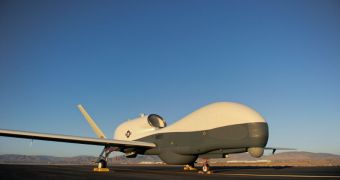Officials at the Northrop Grumman Corporation presented the first MQ-4C Triton Broad Area Maritime Surveillance Unmanned Aircraft System (BAMS UAS) to the US Navy, during a ceremony held in Palmdale, California, on Thursday, June 14.
According to the company, the autonomous flying vehicle is an important strategic element for the US Navy. It is based on the RQ-4 Global Hawk aircraft, which received some modifications to support maritime operations.
A Block 10 RQ-4 UAV equipped with maritime sensors, called the BAMS-D (demonstrator), already entered active duty with the US Navy's Fifth Fleet some time ago, and its performances have thus far been excellent.
The test vehicle was developed as a demonstration of the capabilities that the fully developed Triton would have when it enters active duty as well. One of the selling points for the vehicle is the new, 360-degree Multi-Function Active Sensor (MFAS) radar system.
Developed by engineers at Northrop Grumman Electronic Systems, the instrument is capable of augmenting the radar capabilities of ships that operate around the area the Triton is patrolling.
Each standard RQ-4 costs around $104 million. A clear price for the maritime version of the aircraft has not been disclosed. What analysts do know is that 4 MQ-4C have been ordered thus far, and that an additional 64 are planned.
“Northrop Grumman is proud to provide our US Navy customer with the MQ-4C Triton unmanned aircraft, a key element of the BAMS UAS program, representing the future of naval aviation and a strategic element of the US Navy,” Duke Dufresne explains.
“The BAMS UAS program will revolutionize persistent maritime intelligence, surveillance and reconnaissance. We are honored to serve the US Navy and our nation's allies in the quest to build and maintain a strong and cooperative global maritime domain,” he adds.
Dufresne holds an appointment as the sector vice president and general manager for unmanned systems at Northrop Grumman Aerospace Systems, the division that developed the Triton UAS.
The Northrop Grumman BAMS aircraft will be used primarily for maritime intelligence gathering, surveillance and reconnaissance of enemy positions. Its software was developed in such a manner that it can be integrated with other systems that the Navy currently operates on its fleets.
“Today is a significant day for the BAMS team. The work they have done and will continue to do is critical to the future of naval aviation,” adds Rear Admiral Bill Shannon, the Navys unmanned aviation and strike weapons program executive officer.
“Their efforts will enable the BAMS system to provide the fleet a game-changing persistent maritime and littoral intelligence, surveillance and reconnaissance capability,” he concludes.

 14 DAY TRIAL //
14 DAY TRIAL //